Duopoly in ICT Sector of the UAE
- Duopoly limits;
- Market competition.
- Product development.
- Legal environment:
- Law and the Competition Law regulates telecoms and competition across the country.
- Emirates Telecommunications Corporation (Etisalat).
- Emirates Integrated Telecommunications Company (du).
With the growing global need to digitalize all industries, the role of information and communication technologies (ICTs) becomes especially important. In the UAE, there are two telecommunications operators, such as Emirates Telecommunications Corporation (Etisalat) and Emirates Integrated Telecommunications Company (du). This duopoly structure limits the market competition and product development. The current legal environment of the UAE is another factor that impedes the progress in the field of ICT. In this connection, it is critical to analyze Law and the Competition Law of the country to identify regulatory flaws and provide pertinent recommendations for the market.
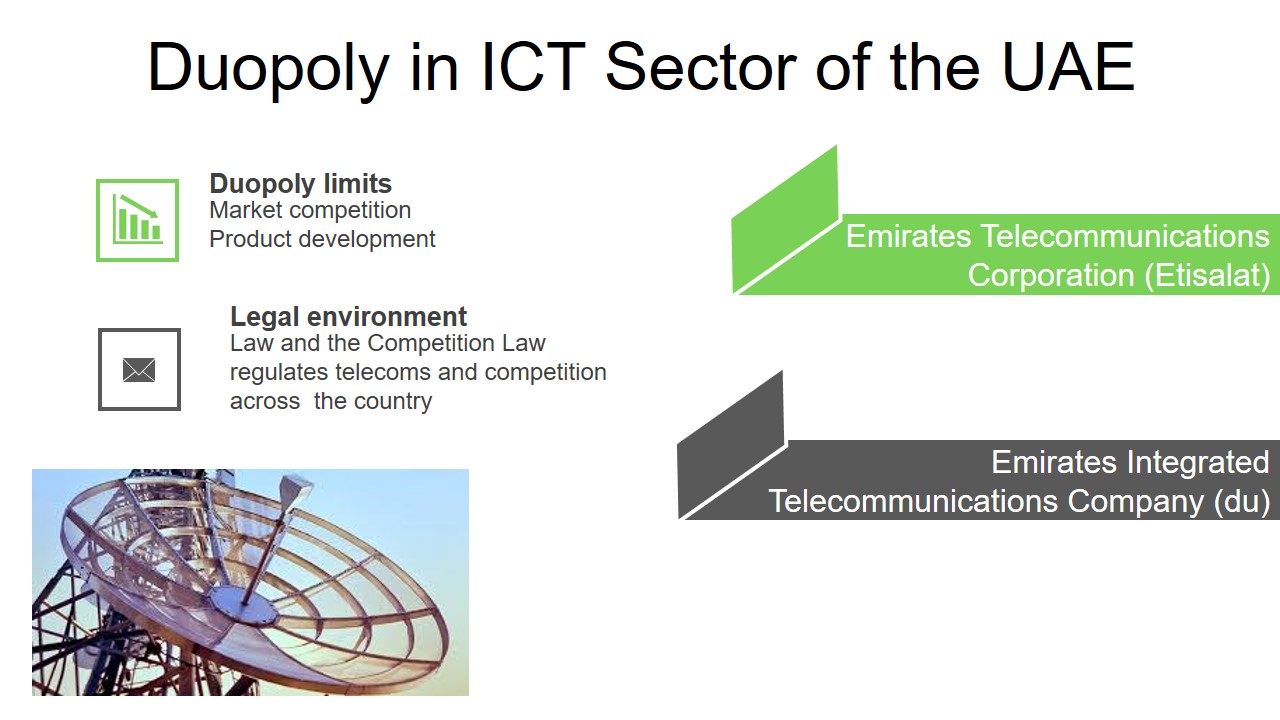
Telecommunications Regulatory Authority (TRA)
- Innovation Objectives:
- Promotion and development of new technologies
- Infrastructure enhancement
- Investment in research and development (Kovacs 2014)
- Practice:
- TRA protects the current duopoly in the ICT market
- Social Objectives:
- Uninterrupted and universal Service provision
- consumer protection:
- Personal data confidentiality
- Operational transparency
- Public communication networks
- TRA fails to ensure options:
- Customers have limited opportunities to select in the telecom sector (Enhan 2016).
The overview of the sector-specific regulations in the UAE shows that the Federal Law by Decree No. 3 of 2002 Regarding the Organization of the Telecommunications Sector is the main law. According to it, the Telecommunications Regulatory Authority (TRA) is assigned the role of monitoring service quality, creating and enforcing relevant policies, norms, and rules, as well as promoting the sector development. Among the key innovation objectives, it is important to mention the promotion of modern technologies, which are expected to enhance competition, which is also proposed to be supported by the investment in research. However, the existing position of the TRA protects the duopoly state on the UAE’s ICT market. The social objectives that are presented on the slide aim to ensure the social well-being of the Emirati population by providing consumer protection and safe Internet experience, as stated in UAE Federal Telecom Law No. (3) for the year 2003 and its amendments. The policy analysis makes it clear that the existing regulatory framework cannot provide customers with the opportunity to choose among the companies in the telecom sector.
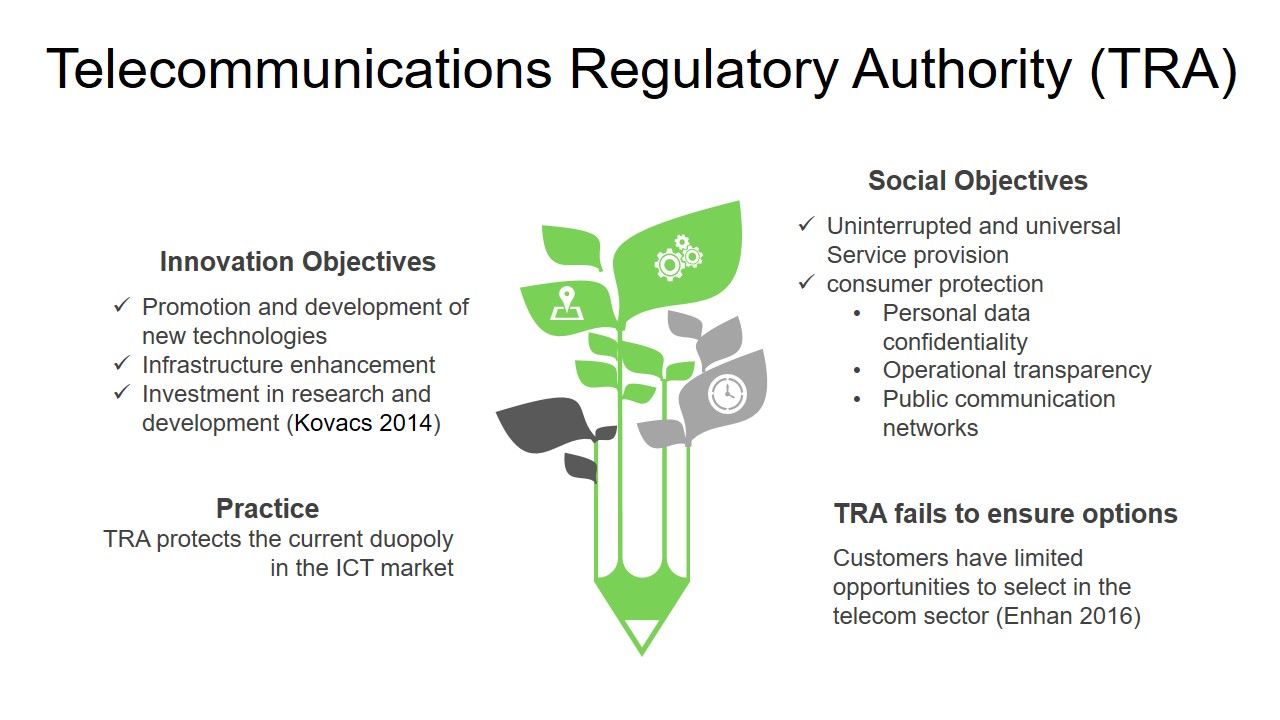
Competition Law
Responsible Bodies:
- the Ministry of Economy.
- the Competition Regulation Committee (2013).
- the UAE government.
Regulation Objectives:
- Economic Efficiency Promotion:
- Creating a competition-driven market;
- Minimizing abuse power of monopolists;
- Orientation Towards Innovation:
- Continuous quality enhancement;
- Strategic thinking;
- Addressing Flaws:
- Regulation is on the developmental stage.
The UAE’s completion law that was enacted in 2013 controls anti-competitive practices by reviewing the related agreements and behaviors as well as mergers between the large companies. In particular, it is required that the “mergers between entities with a sufficiently large combined market share [must] obtain clearance in advance from the Ministry of Economy” (Bowden & Girot, 2017, par. 1). In turn, the Competition Regulation Committee is created to monitor the completion practices and elaborate on the guidelines that should aid the companies operating in the country. of This independent regulatory authority is closely linked to the UAE government and its directions. Nevertheless, the Committee can also act independently, “without excessive political interference or enterprises lobbying” (Enhan, 2016, p. 44). The competition law is expected to promote the economic efficiency of the telecom sector and lead to a more comprehensive review of the market. The facilitation of the exchange on the market is another objective that is pursued by the mentioned Committee. While discussing the Competition Law, it is essential to pay attention to the fact that the fact that it was adopted only in 2013 points to the developmental stage. One of the statements used by the TRA contradicts the committee’s agenda since the former encourages monopolies not to participate in anti-monopoly policy.
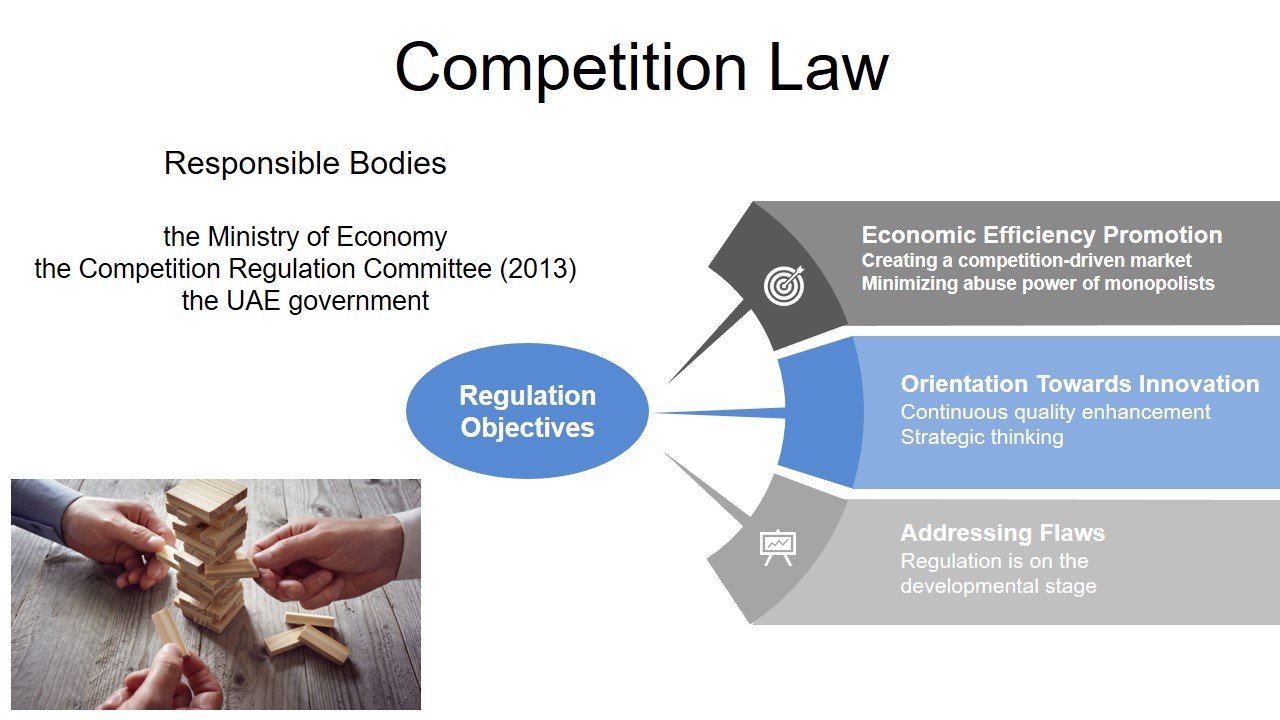
Policy Alternatives
Among the alternatives to the present telecom structure of the UAE, one may suggest liberalization that refers to removing the privileges for Etisalat and du, as well as establishing the independent agencies. Considering that there are only two companies that operate in the ICT sector, it is possible to suggest that the different-quality and distinct-price products would be more demanded by customers, which would stimulate the market growth tremendously. In addition, this alternative would facilitate the implementation of innovations in the sector, which can be driven by the better competition. Privatization is another option that focuses on limiting the ability of the government to intervene in the market. However, it should be stressed that only in case if the government is also committed to the idea of an open market, this alternative would work. One may anticipate that privatization leads to greater economic efficiency and higher revenue volumes. One more alternative is monopoly that is associated with higher product prices and, accordingly, lower product quality and customer demand. While it is also possible to preserve the current duopoly, it is not associated with the market development due to high costs, significant government control, and customer dissatisfaction.
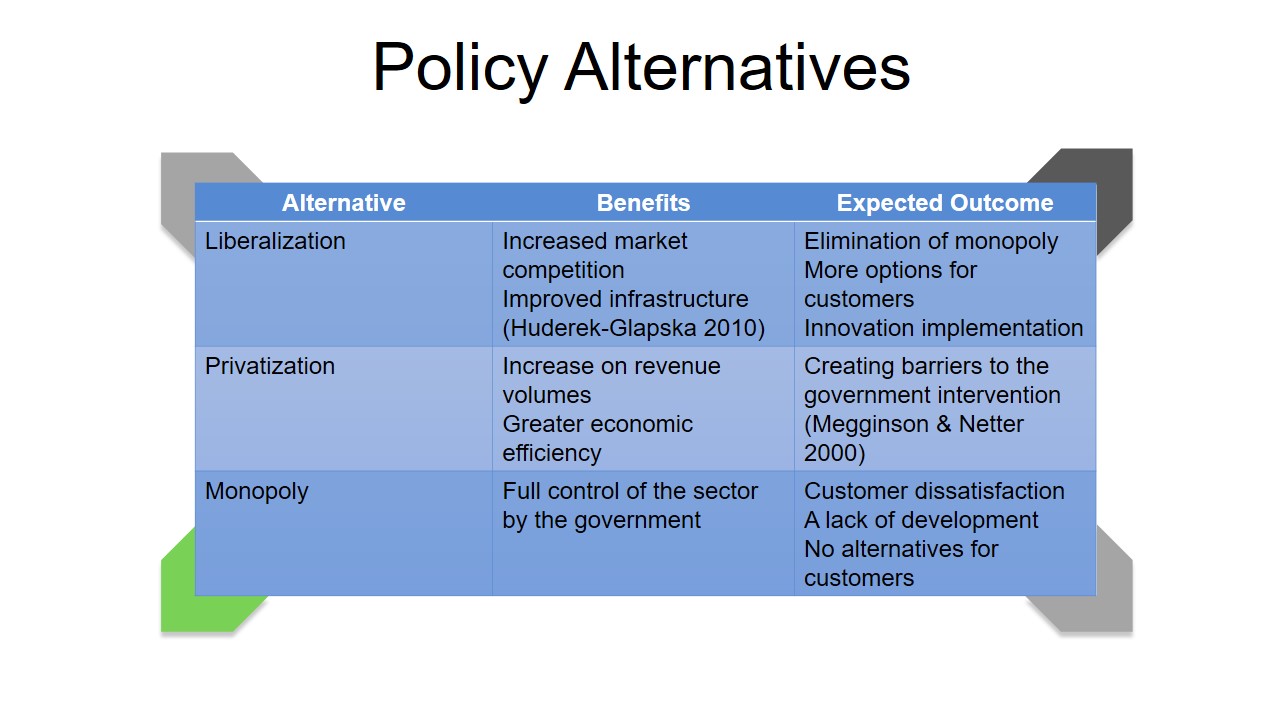
Recommendations
- Gradual introduction of competition in the telecom sector based on Competition Law.
- Inclusion of the telecoms sector in the Competition Law and consequent market liberalization.
- Elimination of conflicts in regulations.
- Facilitation of the market entry control mechanisms to strengthen the competitive force.
- Promote competition-induced labor productivity.
Based on the analysis of the policies that are adopted in the UAE’s telecom sector, it should be recommended to gradually introduce the competition into the market by employing the Competitive Law. The market liberalization should be followed to allow more companies to enter the sector and increase competition. Accordingly, it is important to eliminate the inconsistencies in the regulations. The market entry mechanisms should be facilitated, while competition-induced labor productivity should be encouraged.
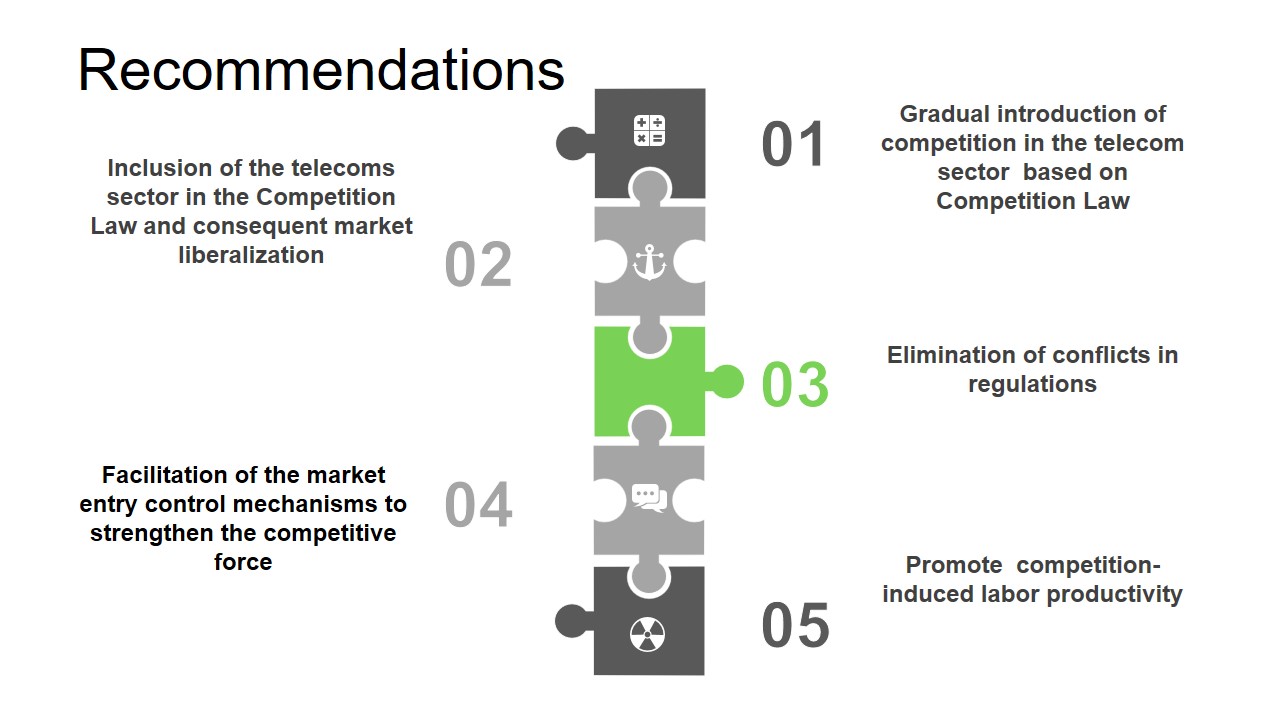
Canadian Pacific Salmon Fishery Case Study
The policy analysis is related to the Canadian Pacific Salmon Fishery case study with regard to the role of the government that intervenes in the market. Both the UAE’s telecom market and Canada’s Fishery lack economically efficient use, and the policies need to be adjusted to address these insufficiencies. The current regulatory regimes need to be changes, and the case study presents the guideline for the UAE’s telecom sector situation.
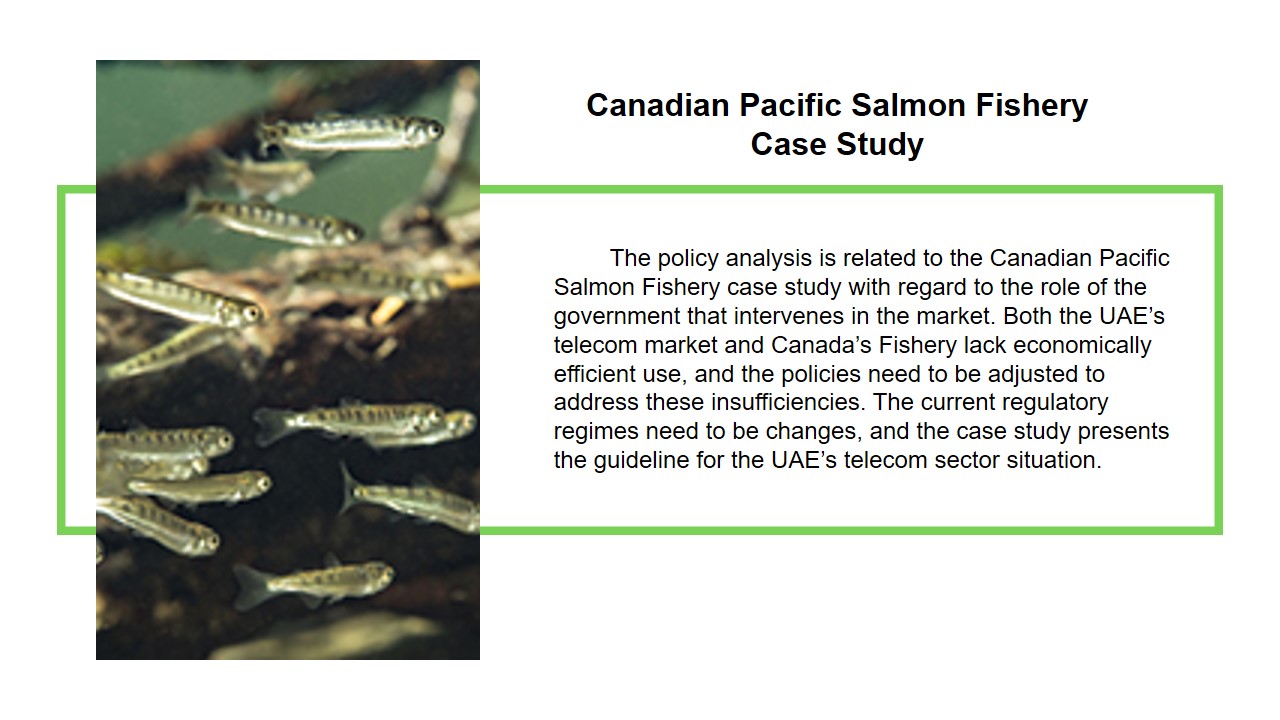
Reference List
Bowden, J & Girot, E 2017, ‘United Arab Emirates: the UAE competition law clarified’, Mondaq. Web.
Enhan, L 2016, Competition and regulation in the telecommunications Industry, Universitat Autònoma de Barcelona, Barcelona.
Huderek-Glapska, S 2010, ‘Economic benefits of market liberalization. Evidence from Air Transport in Poland’, Journal of International Studies, vol. 3, no. 1, pp. 49-58.
Kovacs, J 2014, Economic and legal analysis of the United Arab Emirates’ Telecommunications Market, Central European University, Budapest.
Megginson, WL & Netter, MJ 2000, From state to market: a survey of empirical studies on privatization, OECD, Paris.